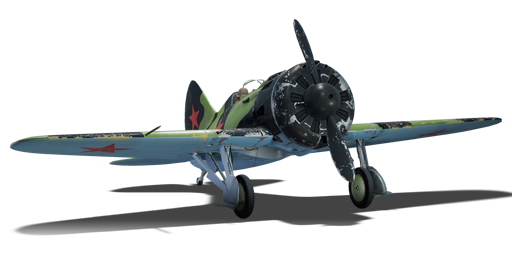

Aviation
I-16 type 18
I
Rank
AB
2.3
RB
2.3
SB
2.3
Battle rating
USSR
Research country
Fighter
Main role
3,000

Research
6,300

Purchase
General information
The I-16 type 18 is a modified version of the Soviet monoplane fighter from the 1930s that was commonly nicknamed the "Ishak." It became a symbol of the Red Army Air Force and remained the USSR's main fighter until 1942. However, by the start of the Great Patriotic War, it was outdated and was soon replaced by the Yak-1 and La-5. The type 18 differs from its predecessor, the type 10, in that it has an M-62 engine, like the I-153. It was developed during the battles at Khalkhin-Gol.
The I-16 type 18 has been in the game since the start of the Open Beta Test prior to Update 1.27. It is a highly maneuverable aircraft with decent fixed and suspended armament, but it has low survivability and speed.
Camouflages
Flight performance
Max speed
at 4,400 m
466423493439 km/h
Rate of Climb
19.414.325.114.3 m/s
Turn time
16.317.915.617.3 s
Max altitude
9,300 m
Takeoff Run
210 m
Landing
flaps
flaps
Take-off
flaps
flaps
Combat
flaps
flaps
Air
brake
brake
General characteristics
Crew
1 person
Engine
Length
6.1 m
Wingspan
9 m
Wing Loading
146 kg/m²
Weight:
Base weight
1.651.71.611.7 t
Fuel in main tanks
0.15 t (37m)
Limits:
Max Speed Limit (IAS)
700 km/h
Mach Number Limit
0.75 M
G limit
≈ -7/15 G
Flap Speed Limit (IAS)
260 km/h
Gear Speed Limit (IAS)
260 km/h
Offensive armament
4 × 7.62 mm ShKAS machine gun
Ammunition
3,100 rounds
Fire rate
1,800 shots/min
One-second Burst Mass
0.29 kg
| Belt | Belt filling | Armor penetration (mm) at a distance: | |||||
|---|---|---|---|---|---|---|---|
| 10 m | 100 m | 500 m | 1000 m | 1500 m | 2000 m | ||
| T/Ball/Ball/AP-I/AI | 13 | 12 | 7 | 3 | 2 | 0 | |
| AP-I/AI/API-T | 13 | 12 | 7 | 3 | 2 | 0 | |
| AP-I/API-T | 13 | 12 | 7 | 3 | 2 | 0 | |
| AP-I/AP-I/AP-I/AI | 13 | 12 | 7 | 3 | 2 | 0 | |
Suspended armament
Setup 1
2 × 100 kg FAB-100sv (forged) bomb
Setup 2
2 × 50 kg FAB-50sv (forged) bomb
Setup 3
6 × ROS-82 rockets
Setup 4
6 × RBS-82 rockets
Economy
Repair cost
Basic → Reference
AB
279 → 420 

RB
546 → 821 

SB
708 → 1,065 

Crew training
1,800 

Experts
6,300 

Aces
80 

Research Aces
135,000 

Reward multiplier
AB / RB / SB
20 / 40 / 90 % 

106 % 

Total cost of modifications
5,970 

4,520 

Talisman cost
410 

Research order:
Flight performance | |
|---|---|
Survivability |
|---|
Weaponry | |
|---|---|
Rating by players
You must play more than 3 battles for the last week and more than 10 battles in a vehicle to rate it.
Like:
3
Flight performance:
Not enough ratings
Survivability:
Not enough ratings
Aerial combat:
Not enough ratings
Ground attack:
Not enough ratings
Balance:
Not enough ratings
Tips & Tricks
This space is currently empty
Do you know any interesting vehicle features?
Loading...
No articles about this vehicle yet
Become the first author and get rewards!
Write a guide, tell about interesting historical facts, make a tutorial or simply an interesting post.
No more content